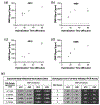From saliva to SNP: non-invasive, point-of-care genotyping for precision medicine applications using recombinase polymerase amplification and giant magnetoresistive nanosensors
- PMID: 35537344
- PMCID: PMC9156572
- DOI: 10.1039/d2lc00233g
From saliva to SNP: non-invasive, point-of-care genotyping for precision medicine applications using recombinase polymerase amplification and giant magnetoresistive nanosensors
Abstract
Genetic testing is considered a cornerstone of the precision medicine paradigm. Genotyping of single nucleotide polymorphisms (SNPs) has been shown to provide insights into several important issues, including therapy selection and drug responsiveness. However, a scarcity of widely deployable and cost-effective genotyping tools has limited the integration of precision medicine into routine clinical practice. The objective of our work was to develop a portable, cost-effective, and automated platform that performs SNP genotyping at the point-of-care (POC). Using recombinase polymerase amplification (RPA) and giant magnetoresistive (GMR) nanosensors, we present a highly automated and multiplexed point-of-care platform that utilizes direct saliva for the qualitative genotyping of four SNPs (rs4633, rs4680, rs4818, rs6269) along the catechol-O-methyltransferase gene (COMT), which is associated with the modulation of pain sensitivity and perioperative opioid use. Using this approach, we successfully amplify, detect, and genotype all four of the SNPs, demonstrating 100% accordance between the experimental results obtained using the automated RPA and GMR genotyping assay and the results obtained using a COMT PCR genotyping assay that was formerly validated using pyrosequencing. This automated, portable, and multiplexed RPA and GMR assay shows great promise as a solution for SNP genotyping at the POC and reinforces the broad applications of magnetic nanotechnology in biomedicine.
Conflict of interest statement
Conflicts of interest
There are no conflicts to declare.
Figures








Similar articles
-
A Tetra-Primer Amplification Refractory System Technique for the Cost-Effective and Novel Genotyping of Eight Single-Nucleotide Polymorphisms of the Catechol-O-Methyltransferase Gene.Genet Test Mol Biomarkers. 2016 Aug;20(8):465-70. doi: 10.1089/gtmb.2015.0304. Epub 2016 May 26. Genet Test Mol Biomarkers. 2016. PMID: 27228319
-
The impact of catechol-O-methyltransferase SNPs and haplotypes on treatment response phenotypes in major depressive disorder: a case-control association study.Int Clin Psychopharmacol. 2010 Jul;25(4):218-27. doi: 10.1097/YIC.0b013e328338b884. Int Clin Psychopharmacol. 2010. PMID: 20531207
-
Quantitative and rapid detection of morphine and hydromorphone at the point of care by an automated giant magnetoresistive nanosensor platform.Anal Bioanal Chem. 2022 Oct;414(24):7211-7221. doi: 10.1007/s00216-022-04274-2. Epub 2022 Aug 19. Anal Bioanal Chem. 2022. PMID: 35986104
-
COMT gene haplotypes are closely associated with postoperative fentanyl dose in patients.Anesth Analg. 2015 Apr;120(4):933-40. doi: 10.1213/ANE.0000000000000563. Anesth Analg. 2015. PMID: 25532715
-
Leveraging Single Nucleotide Polymorphism Profiling for Precision Skin Care: How SNPs Shape Individual Responses in Cosmetic Dermatology.J Cosmet Dermatol. 2025 Jan;24(1):e16750. doi: 10.1111/jocd.16750. J Cosmet Dermatol. 2025. PMID: 39737554 Free PMC article. Review.
Cited by
-
Longitudinal analysis of anti-SARS-CoV-2 neutralizing antibody (NAb) titers in vaccinees using a novel giant magnetoresistive (GMR) assay.Sens Actuators B Chem. 2023 Jul 15;387:133773. doi: 10.1016/j.snb.2023.133773. Epub 2023 Apr 5. Sens Actuators B Chem. 2023. PMID: 37056483 Free PMC article.
-
Generic Platform for the Multiplexed Targeted Electrochemical Detection of Osteoporosis-Associated Single Nucleotide Polymorphisms Using Recombinase Polymerase Solid-Phase Primer Elongation and Ferrocene-Modified Nucleoside Triphosphates.ACS Cent Sci. 2023 Jul 19;9(8):1591-1602. doi: 10.1021/acscentsci.3c00243. eCollection 2023 Aug 23. ACS Cent Sci. 2023. PMID: 37637735 Free PMC article.
-
Advances in point-of-care genetic testing for personalized medicine applications.Biomicrofluidics. 2023 May 3;17(3):031501. doi: 10.1063/5.0143311. eCollection 2023 May. Biomicrofluidics. 2023. PMID: 37159750 Free PMC article. Review.
-
Intact Transition Epitope Mapping-Force Differences between Original and Unusual Residues (ITEM-FOUR).Biomolecules. 2023 Jan 16;13(1):187. doi: 10.3390/biom13010187. Biomolecules. 2023. PMID: 36671572 Free PMC article.
-
A GMR enzymatic assay for quantifying nuclease and peptidase activity.Front Bioeng Biotechnol. 2024 Mar 13;12:1363186. doi: 10.3389/fbioe.2024.1363186. eCollection 2024. Front Bioeng Biotechnol. 2024. PMID: 38544982 Free PMC article.
References
-
- Ashley EA, Nat Rev Genet, 2016,17, 507–522. - PubMed
-
- Manolio TA, Chisholm RL, Ozenberger B, Roden DM, Williams MS, Wilson R, Bick D, Bottinger EP, Brilliant MH, Eng C, Frazer KA, Korf B, Ledbetter DH, Lupski JR, Marsh C, Mrazek D, Murray MF, O’Donnell PH, Rader DJ, Relling MV, Shuldiner AR, Valle D, Weinshilboum R, Green ED and Ginsburg GS, Genet Med, 2013, 15, 258–267. - PMC - PubMed
Publication types
MeSH terms
Substances
Grants and funding
LinkOut - more resources
Full Text Sources
Research Materials
Miscellaneous

